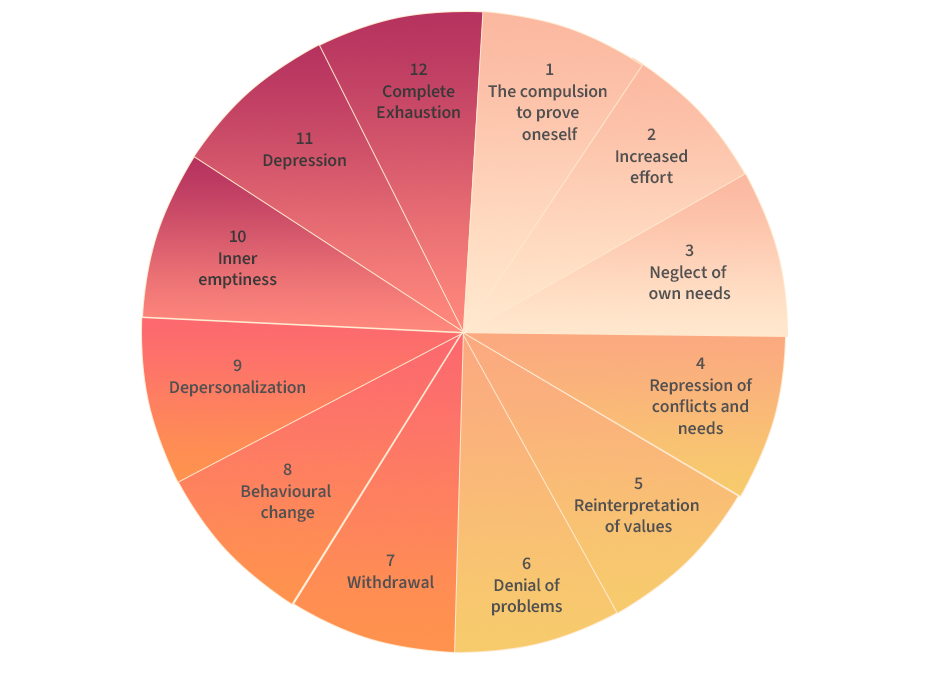Burnout - Symptoms, Signs & Treatment
Lack of strength & a feeling of emptiness are some of the typical first symptoms that burnout tends to bring with it.
In our article you can learn more about the development and treatment of burnout.
Burnout - Exhausted, powerless and feeling empty
Burnt out, helpless and a general feeling of emptiness are the classic terms used by those affected to describe their burnout. A burnout can affect a manager just as much as a houseman, a teacher or a craftsman. The term "burnout" was coined in the 1970s: The US psychotherapist Herbert Freudenberger used it to describe the consequences of heavy stress in "helping" professions, such as doctors and nurses, who sacrifice themselves for others within their work and end up feeling exhausted as well as overwhelmed.
What is a Burnout?
In short, burnout syndrome is a condition that usually occurs due to prolonged overwork either professionally and/or in private life which can lead to a number of mental and physical illnesses. These illnesses include but are not limited to sleep disorders, anxiety disorders or depression.
Burnout does not happen suddenly overnight but develops very slowly and insidiously due to stressful situations, such as pressure to perform, time pressure, fear of losing one's job, a lack of appreciation of one's achievements, and conflicts with superiors and colleagues. A great tendency towards perfectionism, high expectations of oneself and also of others, and a high sense of responsibility can also contribute to the development of burnout. The aforementioned Herbert Freudenberger developed a 12-phase model at the time to demonstrate the course of the clinical picture:
Phase 1: Ambition
This phase is characterised by increased ambition and perfectionism. The person concerned always wants to deliver 120 percent.
Phase 2: Increased commitment to the job
The behaviour from phase 1 intensifies. Tasks must be implemented directly and cannot be delegated.
Phase 3: One's own needs are neglected
Social needs are perceived as secondary. The person’s lifestyle becomes increasingly unhealthy.
Phase 4: Suppression of conflicts and needs
Increasing conflicts - professional or private - are not apparent to the person himself, additionally there is a development of lack of sleep and first physical symptoms start to occur.
Phase 5: Needs become less important
The personal horizon narrows. Things that used to be important to burnout sufferers take a back seat to work.
Phase 6: Denial of problems that have arisen
Occupational overwork and overload are increasingly denied by the individual. Those affected develop cynicism, harshness, and intolerance towards the environment. Loss of performance and physical complaints occur.
Phase 7: Withdrawal
This phase is characterised by disorientation and a state of hopelessness. Those affected try to make themselves happy with substitute satisfactions and often only do their job by the book.
Phase 8: Behavioural changes become apparent
Behavioural changes, such as a lack of critical faculties, an increasing emotional withdrawal from the world of work and a lack of flexibility, now become more and more apparent.
Phase 9: Loss of perception of self
This phase is also called "depersonalisation". Affected people have the feeling that they are no longer themselves and that they only function robotically. Their meaning of life is no longer apparent.
Phase 10: Inner emptiness
Affected people feel worthless and useless. Anxiety and addictive behaviour can occur.
Phase 11: Depression
In this phase, depression can increase. Affected people feel a strong sense of meaninglessness in everything and can no longer muster any motivation.
Phase 12: Complete exhaustion
The absolute climax of burnout is total emotional, mental and physical exhaustion.
This shows very clearly how slowly and insidiously the burnout syndrome develops. To prevent it from getting to this point, it is important to take the first signs seriously and to react early. On the one hand as a individual when looking at your own life but just as much as an employer or colleague.

Signs of burnout
A certain exhaustion and inner emptiness is of course absolutely normal from time-to-time in stressful life situations. The question is at what point you have to admit to yourself that it is more than a little exhaustion.
Since burnout does not have a clearly defined clinical picture, there is also no exact diagnostic criteria. Currently, there are about 130 known signs of burnout. "Exhaustion" and "burnout" are probably among the most frequently mentioned. It is also typical for this illness that even longer breaks, such as a holiday, are not enough to make these feelings of exhaustion and emptiness disappear.
I think I have a burnout - now what?
If you notice various signs and perhaps have even felt like something could be wrong since several weeks or months, you should not be afraid to see your doctor. Through a personal conversation and evaluation, he or she will clarify whether you are suffering from a burnout or perhaps another mental illness.
What can employers do?
Employers and managers definitely have a responsibility for their employees and their physical and mental health and safety. They should therefore keep a certain eye on each employee and react quickly when they see the first signals of a potential burnout. De-tabooing is an important first point: apart from open discussions, this includes relieving the burden on the person at risk, improving work organisation and maintaining constant contact and an open conversation with the employee. Improving the work atmosphere, targeted support for employees as well as appreciation and gratitude towards the employee and of the work that has been done, are also important cornerstones that can prevent employees from slipping into a burnout. Maintaining these conversations and checking-in with employees regularly – personally or anonymously – are also measures to make sure that your employees are doing – and staying – well at the workplace.
Szeretne többet megtudni a myhive-ról?
Foglalja le látogatását és tudjon meg többet.
